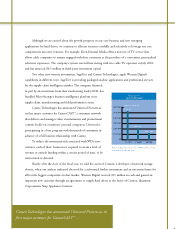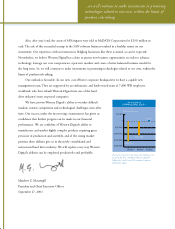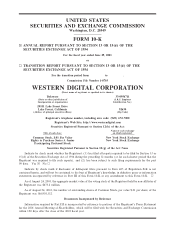Western Digital 2001 Annual Report Download - page 18
Download and view the complete annual report
Please find page 18 of the 2001 Western Digital annual report below. You can navigate through the pages in the report by either clicking on the pages listed below, or by using the keyword search tool below to find specific information within the annual report.computer manufacturers. Western Digital, Quantum, Maxtor and Seagate have historically had the highest
market share with these manufacturers. During 2001, Maxtor acquired the hard drive business of Quantum.
However, the remaining number of qualiÑed suppliers to the leading manufacturers, combined with the
continued growth of the sub-$1,000 PC market and a recent economic slowdown, has placed continuous
downward pressure on hard drive prices. This pressure, in turn, has reduced average gross margins for hard
drive suppliers.
The leading PC computer manufacturers have been gaining market share, which has increased their
purchasing leverage over component suppliers. In calendar year 2000, the top ten desktop personal computer
manufacturers accounted for more than 58% of all shipments and a signiÑcant amount of the growth in the
desktop PC market. As a result, maintaining customer satisfaction with these leading computer manufacturers
has become even more critical.
Computer manufacturers typically seek to qualify up to three or four providers for each generation of hard
drives. Once a computer manufacturer has chosen its qualiÑed hard drive vendors for a given product, it
generally will purchase hard drives from those vendors for the life of that product. To achieve consistent
success with computer manufacturers' qualiÑcations, a hard drive supplier must be an early provider of next
generation hard drives featuring leading technology and high capacity per disk. Suppliers must quickly achieve
volume production of high quality and reliable hard drives. To quickly achieve high volume production, a hard
drive supplier must have access to Öexible, high-capacity, high-quality manufacturing capabilities. Factors on
which computer manufacturers evaluate their hard drive suppliers include overall quality, storage capacities,
performance characteristics, price, ease of doing business, and the supplier's long-term Ñnancial stability.
The business models of computer manufacturers have been changing, and these changes have impacted,
and will continue to impact, Western Digital's sales, inventory and distribution patterns. Most of the computer
industry has used a forecast-driven, long-production-run logistics model. This model limits the computer
manufacturers' Öexibility to react to rapid technology changes and component pricing Öuctuations. Some of
the Company's customers have implemented a supply chain logistics model that combines ""build-to-order''
(computer manufacturer does not build until there is an order backlog) and ""contract manufacturing''
(computer manufacturer contracts assembly work to a contract manufacturer who purchases components and
assembles the computer based on the computer manufacturer's instructions.) The Company has adapted its
logistics model to eÅectively align with these industry shifts. These changes require greater skill in managing
Ñnished goods inventory and more Öexibility in manufacturing, both of which in turn require even closer
relationships between the Company and its computer manufacturer and contract manufacturer customers. To
help meet these challenges, the Company is expanding its use of Internet technology and web-based supply
chain planning tools.
For an additional discussion of the changes in customer models, refer to Part II, Item 7, under the
headings ""Risk factors related to the hard drive industry in which we operate,'' and ""Risk factors related to
Western Digital particularly.''
The Company maintains a base stock of two to three weeks of current, Ñnished goods inventory for
certain key computer manufacturer customers in facilities located adjacent to their operations. Inventory at
these locations usually includes minor product customizations (such as labeling) for the related computer
manufacturer. If subsequent to its initial order the computer manufacturer changes its requirements, inventory
held at these facilities can be sold to other computer manufacturers or distributors as is or with minor
modiÑcations (such as a change in labeling) at little or no additional cost. Therefore, these arrangements, even
if not fulÑlled, have minimal impact on inventory valuation.
Distributors. The Company uses a select group of distributors to sell its products to small computer
manufacturers, value-added resellers, resellers and systems integrators. The Company's major distributor
customers include ASI, Decision Support Systems, ELD, Ingram Micro, Merisel, Servex, Synnex and Tech
Data. Distributors and retailers combined accounted for approximately 30%, 35% and 41% of disk drive
revenue for 1999, 2000 and 2001, respectively. Distributors generally enter into non-exclusive agreements with
8
























